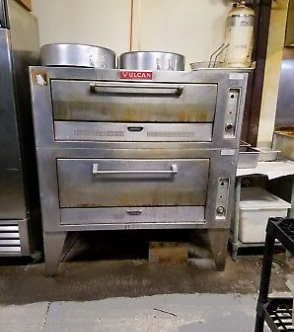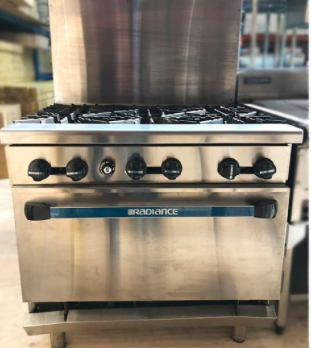We carry a broad range of used commercial ovens listed for sale by owner so you get the best price possible. Our inventory includes convection ovens, steam ovens, conveyor ovens, finishing ovens, toaster ovens and more. Browse the active listings below to see photos, detailed descriptions, and photos of the equipment. Click here to to see our full inventory of restaurant equipment.
[display_listings l_type=”92″]
Introduction to Commercial Ovens

Whether you’re building a kitchen from scratch, or replacing a piece of broken equipment, whether you’re building a kitchen in a food truck, concession trailer, mobile food unit, or a full-blown restaurant kitchen, and whether you’re baking huge volumes of bread for commercial resale, or just roasting a chicken once in a while, the commercial oven is the nerve center of your commercial kitchen endeavors. When your oven breaks down, stops working, or simply starts getting a little wonky, it can dramatically impact the workflow of the rest of your kitchen.
Unlike the range you probably have in your home, commercial ovens are designed for heavy, constant use. Commercial ovens are typically larger than residential ovens, offer more robust options for cleaning and ventilation, and are made of higher-grade materials, such as solid stainless steel.
But commercial ovens aren’t just built better than residential ovens; they often perform better, too. A commercial oven will generally come up to temperature quicker, may heat to higher temperatures, and are better at retaining heat, even through dozens of cycles of opening and closing the door. Commercial ovens are energy efficient, and may contain additional features not found in home models, including heat-resistant knobs, steam absorbents to help keep food crisp, and curved interiors.
All of that extra functionality can come at a premium, however. A quality commercial grade oven can cost tens of thousands of dollars; a pretty penny, when you consider you can score a residential stove from the scratch-and-dent section of your local home improvement store for just a couple of hundred dollars. But because turnover in the restaurant business tends to be so high, you can often find inexpensive used equipment that may not be more than a year or two old. Buying a used oven can save you potentially thousands of dollars, if you shop carefully and know what to look for.
Some popular brands of ovens include Vulcan, Winco, Southbend, Panasonic, Montague, Bakers Pride, Duke, Doyon, Marsal, and Moffat. These are names that have been around for decades manufacturing high-quality restaurant equipment.
What Can You Cook in a Used Commercial Oven?

Used commercial ovens come in dozens of different shapes and sizes, and each uses slightly different technology to deliver the results you want. Let’s start by taking a quick look at the different types of commercial ovens available, as well as which ovens are best suited for each specific task.
Accelerated cooking ovens blend the best elements of both microwave cooking with conventional ovens, delivering powerful, fast, and even heating. These types of ovens are typically smaller than traditional commercial kitchen ovens, and are an ideal choice for smaller restaurant kitchens, university mess halls, hotels, hospitals and convenience stores.
Convection ovens contain fans which move the hot air around, distributing heat over the surface of food for more rapid, even cooking. While faster than traditional ovens, convection ovens tend to be slightly slower, and with a larger physical footprint than rapid cook ovens. Convection ovens are equally well suited for both smaller businesses, and large commercial kitchens.
Steam ovens incorporate water into the cooking process, adding a tank of heated water to fill the oven with screaming-hot steam. The one-two punch of heat and steam makes food taste great without the risk of burning. However, steam ovens don’t brown food, so you may need to adapt your cooking technique and recipes to accommodate this limitation.
Convection steam ovens combine the powers of convection cooking with steam cooking, offering the choice between steamed and moisture-free convection cooking. While the maintenance and cleaning routine may be more vigorous than for other oven types, the flexibility of ovens employing this type of technology can save money over the long term.
Toaster ovens are probably already pretty familiar to anyone that’s reheated a slice of leftover pizza at some point in their lives; these types of ovens use twin cooking elements on the top and bottom of the unit, designed to cook food from both sides at the same time. Toaster ovens are highly efficient and fast, and can be a great option for both large and small restaurants cooking modestly-sized meals.
Pizza ovens come in many different shapes and sizes, but are typically large, with heated decks and low ceilings designed to produce a very high, very dry, and very level heat ideal for cooking pizzas. Pizza ovens usually have stone, cast iron, or ceramic decks, which makes them an obvious choice for pizza restaurants or any restaurant that depends on high heat and lots of cooking space.
Finishing ovens (or “salamanders”) function similarly to a broiler in a home kitchen setting; these ovens cook only the outer surface of food, which makes them a good choice for melting, toasting, or browning the surface of food that has been previously prepped or cooked.
Conveyor ovens feature a large conveyor belt, which moves food slowly through the cooking environment with raw food or ingredients entering one side, and piping-hot, finished food exiting the other. This type of oven is a good choice for high-volume businesses that need to keep a constant supply of food moving through the kitchen, such as pizza or hot toasted sandwich restaurants.
How Do You Evaluate a Used Commercial Oven?

Buying a commercial oven used instead of new is a great place to start cutting costs in your equipment-buying needs for your commercial kitchen. Unlike other types of commercial cooking equipment, used ovens don’t sacrifice much in terms of performance versus their new, more expensive counterparts. A used oven may lack some of the bells-and-whistles of a newer model, such as increased energy efficiency, digital controls, or that new-car smell, but a used oven can usually meet the same goal of “making cold food hot,” as a new oven.
Of course, when buying a used commercial oven, you do run the risk of experiencing a breakdown or needing maintenance sooner than with a new oven. Newer ovens tend to have more technologically advanced features which may be convenient, but which also makes them more prone to breakdown.
When evaluating a used commercial oven for potential purchase, we recommend ovens which contain fewer advanced features, rather than the latest computer-controlled all-digital behemoths. Look for gas-fired ovens (if your kitchen setup will provide for gas appliances), since these tend to have a simpler design, be less prone to breakdown, and less costly to repair than their electric counterparts.
Check the seals around the oven door to make sure there’s no loss of heat, and use an infrared thermometer to check for “cold spots” and “hot spots” in the oven. You’ll also want to check to make sure that the temperature readout on the dial matches the temperature inside the oven itself; we’ve seen ovens where the temperature can be off by as much as fifty degrees, which can cause a lot of unwanted surprises in a busy commercial kitchen. Remember that the temperature readout on the display or knob can usually be calibrated inside the oven itself, so if the temperatures don’t match, check that before deciding whether or not to pass on the sale. Finally, when it comes to aesthetics, remember: An oven that looks like a mess, but which provides quick, consistent, even heat is preferable to a shiny, cosmetically perfect oven with all of the bells and whistles, but which can’t hold a temperature.
If something doesn’t seem to be working right with the used commercial oven you are considering, or if there are known problems with the oven, contact the manufacturer prior to closing the deal to check on the replacement price of parts that are prone to failure. You may be able to negotiate an amazing price on an oven that the current owner thinks of as “broken,” if you’re willing to have it repaired yourself inexpensively.
